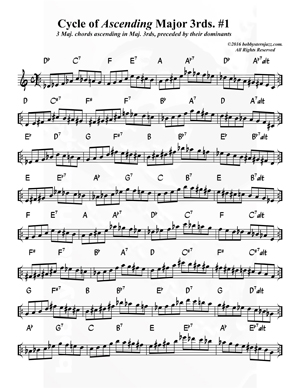A ‘Trane Back@sswards - The Cycle of Ascending Major Thirds

Despite its notoriety, "Giant Steps" is but one of 9 known Coltrane originals in which he featured, in whole or in part, the Cycle of Descending Major 3rds, aka "Coltrane Changes ("Countdown", "Satellite" and "26-2" are some of the others).
Originally, 'Trane's intended use of this cycle was as a substitution for the more mundane ii-V7 harmonic movement as well as a device, which in his own words, "...would take me out of the ordinary path".
Since the Cycle of Major 3rds uses three key centers and divides the octave into 3 equal parts, regardless of direction (eg. B-G-Eb / descending or B-Eb-G / ascending), this poses a question: What's the difference in the quality and effect of a descending cycle (Coltrane Changes, aka Giant Steps Changes), as opposed to an ascending one?
To ponder this query, let's take a few giant steps back, so that we might get a more cosmic view of the larger picture. Shall we?
Each of the 4 bar piano examples below contains a complete cycle with repeat, with the last two quarter notes of measure #4, in each case, representing a ii-V7 turnaround back to the top. They are presented here at a slow 100 bpm, using basic shell voicings (root, 3rd & 7th), and written an octave up from where they sound for easier reading.
Both examples are in "Giant Steps" key - B concert.
Ex. 1:
Cycle of Descending Major 3rds (aka "Giant Steps" changes or "Coltrane Changes"):
B Maj D7 / G Maj Bb7 / Eb Maj F#7 / B Maj
Listen
(Opens in new tab / window)

That's the basis for "Giant Steps", "Countdown", "Satellite", etc. But you knew that already, right!?
While an understanding of the root movement can be important, thinking of each chord as its own, separate harmonic entity can give one the impression that there's more here to navigate than there really is.
Because the dominant chord on beats 3 & 4 of each measure and the tonic chord on beats 1 & 2 of the following measure are V7 - I to the same key, there are really only 3 harmonic entities (key centers) to deal with rather than 6.
With this in mind, it becomes much easier to create basic digital (as in fingers, not 1s & 0s) patterns and arpeggios, as Coltrane did, which cover both the dominant and tonic chords and treat them as a harmonic pair. This holds true for both cycles (Ex 3 & 4).
Cycle of Ascending Major 3rds:
B Maj Bb7 / Eb Maj D7 / G Maj F#7 / B Maj
Listen
(Opens in new tab / window)

Upon listening to Ex. 2, one's initial reaction might be, "...kinda sounds & feels like "Giant Steps", but...it's different!"; which would be a pretty fair assessment. It's still a Maj 3rd cycle, only the direction has changed; with the obvious difference being in the route taken - low road vs. high road, so to speak.
One thing comes to mind here. Because the Descending Maj 3rd Cycle (Ex. 1) has, what in a classical sense might be considered as being the "stronger" root movement of the two, it's probably no surprise that John Coltrane chose the descending version of the cycle over the ascending one (Ex. 2) for his "device". I think it would be safe to assume that he was well aware of both versions, and he made his choice.
That's not to say that the ascending cycle can't be just as interesting or useful. To the contrary, I feel that its possibilities are definitely worthy of further investigation and exploration, don't you?
Besides direction, another important difference between these two examples is, in each case, the different possibilities for connecting the Maj. and dominant chords melodically in each measure.
To illustrate this difference, the line in the example of your basic "Giant Steps" formula below (Ex. 3) uses a 'Trane-like digital 1-2-3-5 pattern for the tonic Major key and chord (B Maj), for the first 2 beats of measure #1; followed by the dominant (D7) of the new key a Major 3rd lower (G Maj) in bar #2. The 5-4-3-2 numerical annotation refers to scale steps of the new key, and not its dominant, which resolves neatly back to the tonic (G - scale step 1).
This pattern repeats itself for the next 2 measures (the new key centers being G and Eb) with measure #4 being a ii-V7 turnaround, prolonging the movement back to B Maj in measure #1. Coltrane would usually have a ii-V here leading into a different set of key centers ("Satellite", "Giant Steps", "26-2", etc.).
Ex. 3:

The connection points between the Maj and dominant chords are different in each cycle - notes F# & D connect chords B & D7 in measure#1 of Ex. 3 (descending cycle) - while at the same spot in Ex. 4 (ascending cycle), notes F# & Bb connect chords B & Bb7. Notice that both connection points are intervals of a Maj 3rd - one descending, the other ascending.
This basic, symmetrical melodic pattern is just the tip of the iceberg of melodic possibilities. It outlines the harmony and connects the key centers easily. It may not be something you'd use all the way through if you were actually improvising, but as an exercise, it's an excellent way to get this cycle into your ears, brain, and under your fingers.
Ex. 4:
Ok! So now that you've seen, heard, and got a whiff of both the Descending and Ascending versions of the Maj 3rd cycle, you might be asking yourself, "What's the purpose!?", or "I have enough trouble playing "Giant Steps", why do I need to add this to my headaches?"
My answer to the first question, which applies to the second as well, is that one needs to be reminded once again of Coltrane's original intention for this cycle; which was as a substitution and enhancement device for the garden variety ii-V7-I chord progression. Being fluent in both of these cycles (and others, as well) will only increase your options and open up new avenues of discovery.
To the second question, I would answer simply; put the tune "Giant Steps", to the side for the time being! Focus on learning it's main element, the Cycle of Maj 3rds, descending and ascending, and the universe will open up and "Giant Steps" truths will reveal themselves to you in abundance!
Treble Clef Bass Clef


 RSS Feed
RSS Feed









